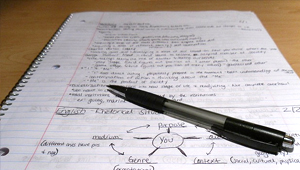How to take best notes during the lecture
Mr. Samir Al Baghdadi
The process of taking the best begins even before the lecture starts. That means the very first step in taking excellent lecture notes is to get organized. It’s helpful to have a three ring binder for each of your subjects. Knowing how you organize yourself is entirely up to you. However, the better organize your are, the easier it is going to be for you to study your notes.
Note-taking strategies
Before you even put pen to paper, it’s important that you find the best seat in the lecture hall. Usually that means front and center. The goal of choosing the best seat is to find a spot that lets you hear what your instructor is telling you, and also gives you adequate visual space to see the board and any projection screens that your professor may use.
Being an active listener is the next stop on your list of taking the best notes. The goal of taking notes is not just to copy down what your instructor says, but to be able to understand the concepts, key terms, and diagrams that may be presented during lecture. In a topic that is your major, it’s not enough simply to memorize the contents of your notes. It is critically important that you understand the concepts. Being an active listener engages all parts of your brain so that you can understand rather than just memorize. To be an active listener means that you need to remove all distractions that stand between you and the lecture. This also means that you need to make sure you get enough sleep and that you are alert while your professor is speaking. A helpful tip is to put away your cell phone. Don’t be distracted by text messages or other social media platforms during a lecture. Active listening is the process that we learn. You can learn to be an active listener, by participating in the lecture. This means, be prepared to ask questions during the lecture. To prepare for the lecture. Make sure you read your material ahead of time. A helpful tip is to prepare your questions and then asked them during lecture. When you’re fully engaged in the conversation, you’re able to understand the content a lot easier.
Taking the best notes
Note-taking is also an art that you learn to perfect as you go through college. A helpful tip is to divide your paper into three sections. The left column, which should be about 2 inches wide, is used only for writing to terms. The bottom of the page should be a row that is about 2 inches high. This is the spot where you ask your questions, or you write about an event that ties you to your lecture subject. The remaining block the space is where you actually take your notes. So note-taking should be organized. It starts with the topic and contain several subtopics underneath of the main topic. This is also the spot where you put definitions for key terms. Remember that the left column is where you wrote the key terms, but it’s not where you put the definitions. The reason that you don’t put the definitions in the left column is because when it comes time to study your notes all you have to do is fold the paper in half to cover up the written part of your note, and you have an active column on the left that allows you to quiz yourself. As you go down the left: and ask yourself what the definition of words or concepts are. Your ability to answer those questions will give you great insight into which parts of your notes that you need to study further.
Learning how to take notes is not just about writing down everything that your professor says. It’s about containing and organize outline of the lecture, and that includes key terms, concepts, and other resources that your professor may have mentioned. You gain more knowledge of the subject when you understand what the professor’s talking about, rather than simply memorizing what he says. So, as you prepare for this next term take the time to get yourself organized. Set up your binders in such a way that you can take notes effectively during class. Be prepared to sit in the front of the classroom, and in a position that affords you the best opportunity to learn. Make sure that you are prepared to be an active listener. Eliminate all distractions between you and the lecture. Then make sure that you take notes in such a way that the outcome becomes a tool that helps you to study and understand the concepts that your professors try to teach you. These are the tips that lead to great note-taking in great note-taking is what helps to make excellent students.
Search
News

رئيس جامعة الناصر الاستاذ الدكتور عبدالله حسين طاهش يقوم بزيارة تفقدية للجان والقاعات الامتحانية الخاصة بكلية الهندسة وعلوم الحاسوب الاثنين 24 فبراير 2025
قام رئيس الجامعة الاستاذ الدكتور عبدالله حسين ط...
جامعة الناصر تنظم ورشة حول التهيئة الرمضانية لمنتسبيها
نظمت جامعة الناصر صباح اليوم الأثنين 25 شعبان 1...
اختتام المؤتمر العلمي الأول للجامعات اليمنية في صنعاء
اختتم اليوم في العاصمة صنعاء، أعمال المؤتمر الع...
لليوم الثاني على التوالي، استمرار أعمال ونقاشات المؤتمر العلمي الأول للجامعات اليمنية.
تستمر في العاصمة صنعاء لليوم الثاني على التوالي...
بمشاركة جامعة الناصر وبحضور رسمي رفيع انطلاق المؤتمر العلمي الأول في صنعاء
صنعاء 20 شعبان 1446 هجرية الموافق 18 فبراير 202...

